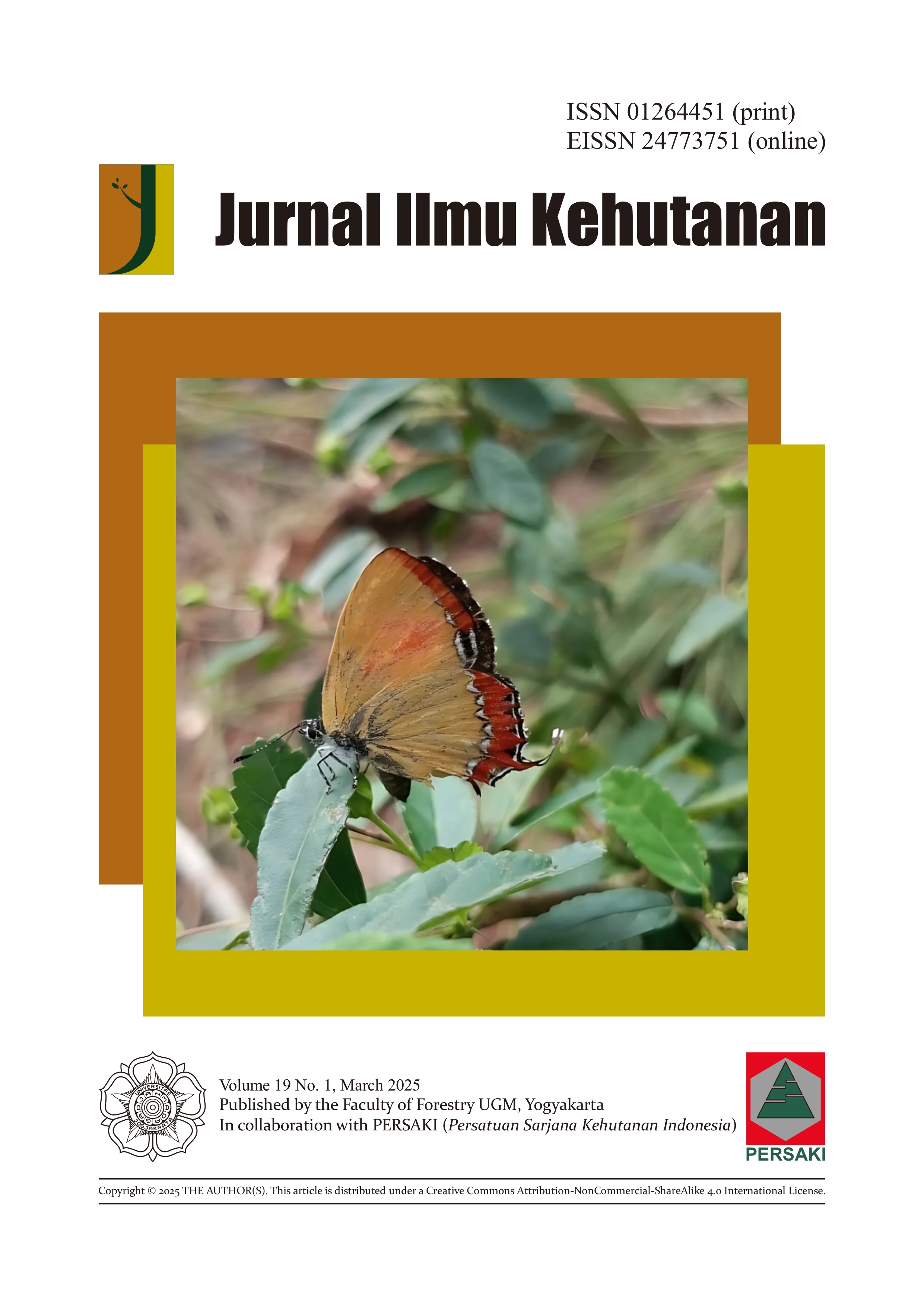Date Log

This work is licensed under a Creative Commons Attribution-NonCommercial-ShareAlike 4.0 International License.
Geospatial Modeling of Carbon Emission Reduction Achievement in Siak Regency, Riau Province
Corresponding Author(s) : Emma Soraya
Jurnal Ilmu Kehutanan,
Vol 19 No 1 (2025): March
Abstract
The Siak Regency implemented the Green Siak Policy in 2016 to commit to reducing carbon emissions. This research aimed to assess land use and land cover (LULC) changes from 2016 to 2023 and make projections for 2030, quantify carbon stocks by LULC type, and estimate CO₂ emissions associated with the implementation of the Green Siak Policy. This research classified LULC using Landsat imagery. It employed the CA-Markov to project land cover in 2030 using eight driving factors: elevation, temperature, rainfall, population density, distance from roads, burned areas, state forest areas, and evidence likelihood. This research assessed carbon stocks using the Integrated Valuation of Ecosystem Services and Tradeoffs (InVEST) model and calculated CO₂ emissions based on changes in LULC and peat decomposition. The findings revealed a slight reduction in total carbon stock from 1,232.52 MtC in 2016 to 1,232.12 MtC in 2023, with annual CO₂ emissions of 1.4 MtCO₂e. Projections indicated an increase in carbon stock, expected to reach 1,232.27 MtC by 2030, with anticipated annual emissions of 1.398 MtCO₂e from 2023 to 2030. While the Green Siak Policy targeted a decrease in emissions of 23.28 MtCO₂e/year by 2030, the results indicated that the Regency achieved merely 0.03% of its target.
Keywords
Download Citation
Endnote/Zotero/Mendeley (RIS)BibTeX
-
Agus, F. (2010). Measuring carbon stock in peat soils: Practical guidelines. World Agroforestry Centre.
Blissag, B., Yebdri, D., & Kessar, C. (2024). Spatiotemporal change analysis of LULC using remote sensing and CA-ANN approach in the Hodna basin, NE of Algeria. Physics and Chemistry of the Earth, Parts A/B/C, 133, 103535. https://doi.org/10.1016/j.pce.2023.103535
Chang, X., Xing, Y., Wang, J., Yang, H., & Gong, W. (2022). Effects of land use and cover change (LUCC) on terrestrial carbon stocks in China between 2000 and 2018. Resources, Conservation and Recycling, 182, 106333. https://doi.org/10.1016/j.resconrec.2022.106333
Eastman, J. R. (2012). IDRISI Selva Tutorial Manual Version 17. Clark Labs, Clark University.
Gharaibeh, A., Shaamala, A., Obeidat, R., & Al-Kofahi, S. (2020). Improving land-use change modeling by integrating ANN with Cellular Automata-Markov Chain model. Heliyon, 6(9), e05092. https://doi.org/10.1016/j.heliyon.2020.e05092
Gibson, L., Münch, Z., Palmer, A., & Mantel, S. (2018). Future land cover change scenarios in South African grasslands – implications of altered biophysical drivers on land management. Heliyon, 4(7), e00693. https://doi.org/10.1016/j.heliyon.2018.e00693
Global Forest Watch. (2024). World Resources Institute. Diakses pada 24 Juni 2024. http://www.globalforestwatch.org
Gubernur Riau. (2022). Peraturan Gubernur Riau Tentang Rencana Pembangunan Rendah Karbon (Pergub Riau No. 56 tahun 2022).
IPCC. (2019). 2019 Refinement to the 2006 IPCC Guidelines for National Greenhouse Gas Inventories (E. E. C. Buendia, K. Tanabe, A. Kranjc, B. Jamsranjav, M. Fukuda, S. Ngarize, A. Osako, Y. Pyrozhenko, P. Shermanau, & S. Federici, Eds.). IPCC, Switzerland.
Kafy, A.-A., Abdullah-Al-Faisal, Rahman, Md. S., Islam, M., Al Rakib, A., Islam, Md. A., Khan, Md. H. H., Sikdar, Md. S., Sarker, Md. H. S., Mawa, J., & Sattar, G. S. (2021). Prediction of seasonal urban thermal field variance index using machine learning algorithms in Cumilla, Bangladesh. Sustainable Cities and Society, 64, 102542. https://doi.org/10.1016/j.scs.2020.102542
KLHK. (2022a). Rencana Kerja Provinsi Riau. Seri-A FOLU Net Sink 2030 Nomor: A-14/Renja-Riau/09/2022.
Krisnawati, H., Imanuddin, R., Adinugroho, W. C., & Hutabarat, S. (2015). Standard methods for estimating greenhouse gas emissions from forests and peatlands in Indonesia: Version 2. Ministry of Environment and Forestry, Research, Development, and Innovation Agency.
Kumar, V., & Agrawal, S. (2023). A multi-layer perceptron–Markov chain based LULC change analysis and prediction using remote sensing data in Prayagraj district, India. Environmental Monitoring and Assessment, 195(5), 619. https://doi.org/10.1007/s10661-023-11205-w
Leta, M. K., Demissie, T. A., & Tränckner, J. (2021). Modeling and Prediction of Land Use Land Cover Change Dynamics Based on Land Change Modeler (LCM) in Nashe Watershed, Upper Blue Nile Basin, Ethiopia. Sustainability, 13(7), 3740. https://doi.org/10.3390/su13073740
Li, C., Zhao, J., Thinh, N., & Xi, Y. (2018). Assessment of the Effects of Urban Expansion on Terrestrial Carbon Storage: A Case Study in Xuzhou City, China. Sustainability, 10(3), 647. https://doi.org/10.3390/su10030647
Liang, Y., Liu, L., & Huang, J. (2017). Integrating the SD-CLUE-S and InVEST models into assessment of oasis carbon storage in northwestern China. PLOS ONE, 12(2), e0172494. https://doi.org/10.1371/journal.pone.0172494
Lillesand, T. M., Kiefer, R. W., & Chipman, J. W. (2015). Remote sensing and image interpretation (Seventh edition). John Wiley & Sons, Inc.
Pemerintah Indonesia. (2022). Enhanced Nationally Determined Contribution Republic of Indonesia.
Rossita, A., Boer, R., Hein, L., Nurrochmat, D., & Riqqi, A. (2023). Peatland fire regime across Riau peat hydrological unit, Indonesia. Forest and Society, 7(1), 76–94. https://doi.org/10.24259/fs.v7i1.21996
Smoot, L. D., & Baxter, L. L. (2003). Fossil Fuel Power Stations—Coal Utilization. In Encyclopedia of Physical Science and Technology (pp. 121–144). Elsevier. https://doi.org/10.1016/B0-12-227410-5/00257-X
Supriatna, S., Mukhtar, M. K., Wardani, K. K., Hashilah, F., & Manessa, M. D. M. (2022). CA-Markov Chain Model-based Predictions of Land Cover: A Case Study of Banjarmasin City. Indonesian Journal of Geography, 54(3). https://doi.org/10.22146/ijg.71721
Verma, P., Siddiqui, A. R., Mourya, N. K., & Devi, A. R. (2024). “Forest carbon sequestration mapping and economic quantification infusing MLPnn-Markov chain and InVEST carbon model in Askot Wildlife Sanctuary, Western Himalaya.” Ecological Informatics, 79, 102428. https://doi.org/10.1016/j.ecoinf.2023.102428
Verwer, C., & Meer, P. V. der. (2010). Carbon Pools in Tropical Peat Forest—Towards a Reference Value for Forest Biomass Carbon in Relative Undisturbed Peat Swamp Forest in Southeast Asia. Wageningen, Alterra, Alterra-report 2108.
Yadav, V. S., Yadav, S. S., Gupta, S. R., Meena, R. S., Lal, R., Sheoran, N. S., & Jhariya, M. K. (2022). Carbon sequestration potential and CO2 fluxes in a tropical forest ecosystem. Ecological Engineering, 176, 106541. https://doi.org/10.1016/j.ecoleng.2022.106541
Yoro, & Daramola. (2020). Advances in carbon capture: Methods, technologies and applications. Elsevier. https://doi.org/10.1016/C2018-0-05339-6
Zhu, L., Xing, H., & Hou, D. (2022). Analysis of carbon emissions from land cover change during 2000 to 2020 in Shandong Province, China. Scientific Reports, 12(1), 8021. https://doi.org/10.1038/s41598-022-12080-0
